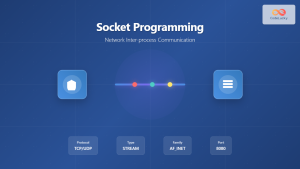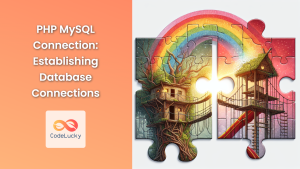In the world of web development, understanding network communication is crucial. PHP, a versatile server-side scripting language, offers powerful tools for socket programming, allowing developers to create robust network applications. This article delves deep into PHP socket programming, exploring its intricacies and demonstrating practical examples to help you master this essential skill.
What is Socket Programming?
Socket programming is a way of connecting two nodes on a network to communicate with each other. One socket (node) listens on a particular port at an IP, while the other socket reaches out to the other to form a connection. The server forms the listener socket while the client reaches out to the server.
🔌 Fun Fact: The term "socket" in this context comes from the analogy of electrical sockets and plugs!
PHP Socket Functions
PHP provides a set of functions for socket programming. Here are some of the most commonly used ones:
socket_create(): Creates a socket (endpoint for communication)socket_bind(): Binds a name to a socketsocket_listen(): Listens for connections on a socketsocket_accept(): Accepts a connection on a socketsocket_connect(): Initiates a connection on a socketsocket_read(): Reads from a socketsocket_write(): Write to a socketsocket_close(): Closes a socket resource
Let's dive into some practical examples to see these functions in action!
Creating a Simple TCP Server
Let's start by creating a basic TCP server that listens for connections:
<?php
// Create a TCP socket
$socket = socket_create(AF_INET, SOCK_STREAM, SOL_TCP);
if ($socket === false) {
echo "socket_create() failed: reason: " . socket_strerror(socket_last_error()) . "\n";
} else {
echo "Socket created successfully.\n";
}
// Bind the socket to an address/port
$result = socket_bind($socket, '127.0.0.1', 8080);
if ($result === false) {
echo "socket_bind() failed: reason: " . socket_strerror(socket_last_error($socket)) . "\n";
} else {
echo "Socket bound to address/port successfully.\n";
}
// Start listening for connections
$result = socket_listen($socket, 3);
if ($result === false) {
echo "socket_listen() failed: reason: " . socket_strerror(socket_last_error($socket)) . "\n";
} else {
echo "Socket is listening for connections.\n";
}
// Accept incoming connections
$client = socket_accept($socket);
if ($client === false) {
echo "socket_accept() failed: reason: " . socket_strerror(socket_last_error($socket)) . "\n";
} else {
echo "A client has connected.\n";
}
// Close the sockets
socket_close($client);
socket_close($socket);
?>
This script creates a TCP server that:
- Creates a socket
- Binds it to localhost (127.0.0.1) on port 8080
- Starts listening for connections
- Accepts one incoming connection
🚀 CodeLucky Tip: Always remember to close your sockets when you're done with them to free up system resources!
Creating a Simple TCP Client
Now, let's create a client that can connect to our server:
<?php
// Create a TCP socket
$socket = socket_create(AF_INET, SOCK_STREAM, SOL_TCP);
if ($socket === false) {
echo "socket_create() failed: reason: " . socket_strerror(socket_last_error()) . "\n";
}
echo "Attempting to connect to '127.0.0.1' on port '8080'...\n";
$result = socket_connect($socket, '127.0.0.1', 8080);
if ($result === false) {
echo "socket_connect() failed.\nReason: ($result) " . socket_strerror(socket_last_error($socket)) . "\n";
} else {
echo "Successfully connected to the server.\n";
}
// Close the socket
socket_close($socket);
?>
This client script:
- Creates a socket
- Attempts to connect to localhost on port 8080
- Closes the socket
Sending and Receiving Data
Let's enhance our server and client to exchange some data:
Enhanced Server
<?php
// Create and bind socket (as before)
// ...
while (true) {
echo "Waiting for incoming connections...\n";
$client = socket_accept($socket);
$message = socket_read($client, 1024);
echo "Received message from client: " . $message . "\n";
$response = "Hello, Client! I received your message: " . $message;
socket_write($client, $response, strlen($response));
socket_close($client);
}
socket_close($socket);
?>
Enhanced Client
<?php
// Create socket and connect (as before)
// ...
$message = "Hello, Server!";
socket_write($socket, $message, strlen($message));
$response = socket_read($socket, 1024);
echo "Received response from server: " . $response . "\n";
socket_close($socket);
?>
In this enhanced version:
- The server reads the incoming message, prints it, and sends a response.
- The client sends a message and then reads the server's response.
📊 Here's a table showing the flow of communication:
| Step | Client | Server |
|---|---|---|
| 1 | Connects to server | Accepts connection |
| 2 | Sends "Hello, Server!" | Reads message |
| 3 | Waits for response | Sends response |
| 4 | Reads response | Waits for next connection |
| 5 | Closes connection | Closes client connection |
Working with UDP Sockets
While TCP provides reliable, ordered delivery of data, sometimes you might need the speed and simplicity of UDP. Let's create a UDP server and client:
UDP Server
<?php
// Create UDP socket
$socket = socket_create(AF_INET, SOCK_DGRAM, SOL_UDP);
socket_bind($socket, '127.0.0.1', 9999);
echo "UDP Server listening on port 9999...\n";
while (true) {
socket_recvfrom($socket, $buf, 1024, 0, $remote_ip, $remote_port);
echo "Received $buf from $remote_ip:$remote_port\n";
$reply = "Thank you for your message: $buf";
socket_sendto($socket, $reply, strlen($reply), 0, $remote_ip, $remote_port);
}
socket_close($socket);
?>
UDP Client
<?php
$socket = socket_create(AF_INET, SOCK_DGRAM, SOL_UDP);
$message = "Hello, UDP Server!";
socket_sendto($socket, $message, strlen($message), 0, '127.0.0.1', 9999);
socket_recvfrom($socket, $buf, 1024, 0, $remote_ip, $remote_port);
echo "Server response: $buf\n";
socket_close($socket);
?>
🌟 CodeLucky Insight: UDP is connectionless, meaning each message is independent. This makes it faster but less reliable than TCP.
Handling Multiple Clients with Non-Blocking Sockets
For a more realistic scenario, let's create a server that can handle multiple clients simultaneously using non-blocking sockets:
<?php
$master = socket_create(AF_INET, SOCK_STREAM, SOL_TCP);
socket_bind($master, '127.0.0.1', 8080);
socket_listen($master, 3);
$read_sockets = array($master);
$clients = array();
socket_set_nonblock($master);
echo "Server started on 127.0.0.1:8080\n";
while (true) {
$read = $read_sockets;
$write = NULL;
$except = NULL;
if (socket_select($read, $write, $except, 0) < 1) {
continue;
}
if (in_array($master, $read)) {
$client = socket_accept($master);
if ($client < 0) {
echo "socket_accept() failed\n";
continue;
} else {
array_push($read_sockets, $client);
$clients[$client] = array();
echo "New client connected\n";
}
$key = array_search($master, $read);
unset($read[$key]);
}
foreach ($read as $read_socket) {
$data = @socket_read($read_socket, 1024, PHP_NORMAL_READ);
if ($data === false) {
$key = array_search($read_socket, $read_sockets);
unset($read_sockets[$key]);
unset($clients[$read_socket]);
echo "Client disconnected\n";
continue;
}
$data = trim($data);
if (!empty($data)) {
echo "Received data: $data\n";
$response = "Server received: $data\n";
socket_write($read_socket, $response, strlen($response));
}
}
}
socket_close($master);
?>
This server can handle multiple clients by:
- Using
socket_select()to monitor multiple sockets - Setting the master socket to non-blocking mode
- Maintaining an array of connected clients
🏆 CodeLucky Challenge: Try extending this server to broadcast messages to all connected clients when one client sends a message!
Error Handling in Socket Programming
Proper error handling is crucial in socket programming. PHP provides socket_last_error() and socket_strerror() functions for this purpose:
<?php
$socket = socket_create(AF_INET, SOCK_STREAM, SOL_TCP);
if ($socket === false) {
$errorcode = socket_last_error();
$errormsg = socket_strerror($errorcode);
die("Couldn't create socket: [$errorcode] $errormsg\n");
}
// ... rest of your socket code ...
// Always good practice to close the socket
socket_close($socket);
?>
Conclusion
Socket programming in PHP opens up a world of possibilities for network communication. From creating simple TCP/UDP servers and clients to handling multiple connections, you now have the tools to build robust networked applications.
Remember these key points:
- Always close your sockets when you're done with them
- Use error handling to make your applications more robust
- Consider using non-blocking sockets for handling multiple clients
- Choose between TCP and UDP based on your application's needs
🚀 CodeLucky Challenge: Try creating a simple chat application using the concepts learned in this article. It's a great way to put your socket programming skills to the test!
Socket programming is a powerful skill in a PHP developer's toolkit. As you continue to explore and experiment, you'll find even more exciting ways to leverage these capabilities in your projects. Happy coding!



















